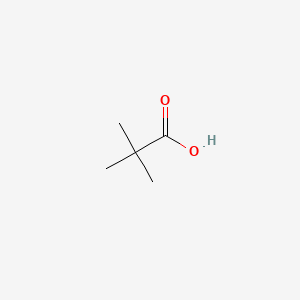| MeSH term | MeSH ID | Detail |
|---|---|---|
| Hemolysis | D006461 | 131 associated lipids |
| Otitis Media | D010033 | 12 associated lipids |
| Arrhythmias, Cardiac | D001145 | 42 associated lipids |
| Body Weight | D001835 | 333 associated lipids |
| Psoriasis | D011565 | 47 associated lipids |
| Urinary Tract Infections | D014552 | 11 associated lipids |
| Seizures | D012640 | 87 associated lipids |
| Dermatitis | D003872 | 30 associated lipids |
| Vitamin E Deficiency | D014811 | 29 associated lipids |
| Hyperinsulinism | D006946 | 27 associated lipids |
Pivalic acid
Pivalic acid is a lipid of Fatty Acyls (FA) class. Pivalic acid is associated with abnormalities such as Renal carnitine transport defect, Carnitine deficiency, Urinary tract infection, Otitis Media and Chronic infectious disease. The involved functions are known as carnitine transport, Uptake, inhibitors, Oxidation and Intestinal Absorption. Pivalic acid often locates in Grey line. The related lipids are pivalic acid and Fatty Acids.
Cross Reference
Introduction
To understand associated biological information of Pivalic acid, we collected biological information of abnormalities, associated pathways, cellular/molecular locations, biological functions, related genes/proteins, lipids and common seen animal/experimental models with organized paragraphs from literatures.
What diseases are associated with Pivalic acid?
Pivalic acid is suspected in Otitis Media, Renal carnitine transport defect, Carnitine deficiency, Urinary tract infection, Chronic infectious disease and other diseases in descending order of the highest number of associated sentences.
Related references are mostly published in these journals:
| Disease | Cross reference | Weighted score | Related literature |
|---|
Possible diseases from mapped MeSH terms on references
We collected disease MeSH terms mapped to the references associated with Pivalic acid
PubChem Associated disorders and diseases
What pathways are associated with Pivalic acid
Lipid pathways are not clear in current pathway databases. We organized associated pathways with Pivalic acid through full-text articles, including metabolic pathways or pathways of biological mechanisms.
Related references are published most in these journals:
| Pathway name | Related literatures |
|---|
PubChem Biomolecular Interactions and Pathways
Link to PubChem Biomolecular Interactions and PathwaysWhat cellular locations are associated with Pivalic acid?
Visualization in cellular structure
Associated locations are in red color. Not associated locations are in black.
Related references are published most in these journals:
| Location | Cross reference | Weighted score | Related literatures |
|---|
What functions are associated with Pivalic acid?
Related references are published most in these journals:
| Function | Cross reference | Weighted score | Related literatures |
|---|
What lipids are associated with Pivalic acid?
Related references are published most in these journals:
| Lipid concept | Cross reference | Weighted score | Related literatures |
|---|
What genes are associated with Pivalic acid?
There are no associated biomedical information in the current reference collection.
What common seen animal models are associated with Pivalic acid?
There are no associated biomedical information in the current reference collection.
NCBI Entrez Crosslinks
All references with Pivalic acid
Download all related citations| Authors | Title | Published | Journal | PubMed Link |
|---|---|---|---|---|
| Rohwerder T and Müller RH | Biosynthesis of 2-hydroxyisobutyric acid (2-HIBA) from renewable carbon. | 2010 | Microb. Cell Fact. | pmid:20184738 |
| Rumschinski P et al. | Set-base dynamical parameter estimation and model invalidation for biochemical reaction networks. | 2010 | BMC Syst Biol | pmid:20500862 |
| Fagerholm AE et al. | Calyculins and related marine natural products as serine-threonine protein phosphatase PP1 and PP2A inhibitors and total syntheses of calyculin A, B, and C. | 2010 | Mar Drugs | pmid:20161975 |
| Kotal A et al. | Ultrasound-induced in situ formation of coordination organogels from isobutyric acids and zinc oxide nanoparticles. | 2010 | Langmuir | pmid:20020763 |
| Zhao XQ et al. | Synthesis, structures and magnetic properties of a series of 3d-4f tetranuclear Co(II)â‚‚Ln(III)â‚‚ cubanes. | 2010 | Dalton Trans | pmid:20401413 |
| Liu TF et al. | An alcoholysis route to a Cu16 cluster, and the influence of the alcohol. | 2010 | Dalton Trans | pmid:20354607 |
| Cox AD et al. | Investigating the candidacy of LPS-based glycoconjugates to prevent invasive meningococcal disease: chemical strategies to prepare glycoconjugates with good carbohydrate loading. | 2010 | Glycoconj. J. | pmid:20340043 |
| Alborés P and Rentschler E | A Co36 cluster assembled from the reaction of cobalt pivalate with 2,3-dicarboxypyrazine. | 2009 | Angew. Chem. Int. Ed. Engl. | pmid:19890926 |
| Boeer AB et al. | Linkage isomerism and spin frustration in heterometallic rings: synthesis, structural characterization, and magnetic and EPR spectroscopic studies of Cr(7)Ni, Cr(6)Ni(2), and Cr(7)Ni(2) rings templated about imidazolium cations. | 2009 | Chemistry | pmid:19859922 |
| Goswami S et al. | Recognition of carboxylate anions and carboxylic acids by selenium-based new chromogenic fluorescent sensor: a remarkable fluorescence enhancement of hindered carboxylates. | 2009 | Org. Lett. | pmid:19728733 |
